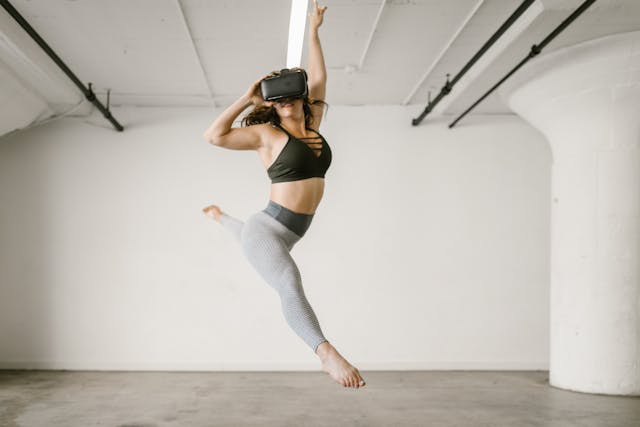Assembling with VR
Dancing in a more than human world
DOI:
https://doi.org/10.31273/eirj.v11i2.1498Keywords:
virtual reality, dance, embodiment, empathy, immersion, presence, Barad, intra-action, assemblageAbstract
In this paper, we consider the claims that constellate around the concepts of immersion, presence and empathy that have been made about virtual reality across many disciplines of study, including psychology, criminology, immersive film and media. These claims are applied to an interdisciplinary, collaborative project: VR Dance; which engaged young people (11-16 years) in hip hop and immersive technology workshops over a six-week period. We discuss the ways in which co-created immersive environments which centre the body offer potential to tune into and re-calibrate our sensitivities and modes of engagement with each other and the environments we are in. We argue that this is not simply as a result of technology’s effects on individuals but constituted in wider assemblages of human and nonhuman actors. We make the case for virtual reality, not as a tool for ‘becoming other’, but as part of wider assemblages in ongoing transformations, relocations, and calibrations.
Funding Acknowledgement
VR Dance is an East London Dance programme, funded by the Mayor of London’s Young Londoner’s Fund & the London Borough of Redbridge and delivered in partnership with the University of Bristol, BirdGang Ltd, Maskomi and PlayLa.bZ.
Downloads

Downloads
Published
Issue
Section
License
Copyright (c) 2024 Lisa Thomas, Debbie Watson, Lois Peach, Nina Ross, Naomi Clarke

This work is licensed under a Creative Commons Attribution 4.0 International License.
Authors who publish with this journal agree to the following terms:
Authors retain copyright and grant the journal right of first publication with the work simultaneously licensed under a Creative Commons Attribution License (CC-BY), which permits use and redistribution of the work provided that the original author and source are credited, a link to the license is included, and an indication of changes which were made. Third-party users may not apply legal terms or technological measures to the published article which legally restrict others from doing anything the license permits.
If accepted for publication authors’ work will be made open access and distributed under a Creative Commons Attribution (CC-BY) license unless previously agreed with Exchanges’ Editor-in-Chief prior to submission.
Authors are able to enter into separate, additional contractual arrangements for the non-exclusive distribution of the journal's published version of the work (e.g., post it to an institutional repository or publish it in a book), with an acknowledgement of its initial publication in this journal.
Authors are permitted and encouraged to post their work online (e.g., in institutional repositories or on their website) prior to and during the submission process, as it can lead to productive exchanges, as well as earlier and greater citation of published work. (see: The Effect of Open Access)
